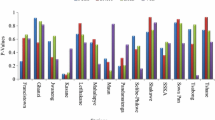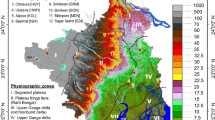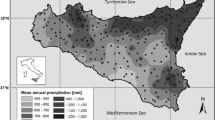Abstract
A spatial model for daily rainfall based on an ordinal logistic regression for the number of wet sites and an ordinary regression for average depth of rainfall at wet sites is presented. The model is fitted to daily rainfall records from a cluster of seven meteorological stations, at the meso-gamma meteorological scale, in South Australia. Data covering a 55-year period from 1958 to 2012 is analysed. The model is used to identify associations between rainfall and four climatic indicators, namely the Southern Oscillation Index (SOI), the Southern Annular Mode (SAM), the Indian Ocean Dipole (IOD) and the Pacific Decadal Oscillation (PDO), and also to monitor changes in rainfall patterns. The results show that there is strong evidence of seasonal variations, in both depth and spatial extent of rainfall, and of persistence of the rainfall pattern from day to day. There is no evidence of trends, but there is evidence of a spatial association between rainfall and SOI, SAM and IOD. There is also evidence of an association between rainfall depth and PDO.







Similar content being viewed by others
References
Alpert P, Ben-Gai T, Baharad A, Benjamini Y, Yekutieli D, Colacino M, Diodato L, Ramis C, Homar V, Romero R, Michaelides S (2002) The paradoxical increase of Mediterranean extreme daily rainfall in spite of decrease in total values. Geophys Res Lett 29(11):311–314
Australian Government Bureau of Meteorology (2016) National Water Account 2016, weblink http://www.bom.gov.au/water/nwa/2016/adelaide/index .shtml [ access on 02/11/2019]
Cai W, Borlace S, Lengaigne M, Van Rensch P, Collins M, Vecchi G, Timmermann A, Santoso A, McPhaden MJ, Wu L, England MH (2014) Increasing frequency of extreme El Niño events due to greenhouse warming. Nat Clim Chang 4(2):111–116
Cowpertwait PS (1995) A generalized spatial-temporal model of rainfall based on a clustered point process. Proc R Soc Lond Ser A Math Phys Sci 450(1938):163–175
Dong B, Dai A (2015) The influence of the Interdecadal Pacific Oscillation on temperature and precipitation over the globe. Clim Dyn 45(9–10):2667–2681
Gabriel KR, Neumann J (1962) A Markov chain model for daily rainfall occurrence at Tel Aviv. Q J R Meteorol Soc 88(375):90–95
Ghosh S, Das D, Kao SC, Ganguly AR (2012) Lack of uniform trends but increasing spatial variability in observed Indian rainfall extremes. Nat Clim Chang 2(2):86–91
Gong H, Zhou W, Chen W, Wang L, Leun MYT, Cheung PKY, Zhang Y (2019) Modulation of the southern Indian Ocean dipole on the impact of El Niño–Southern Oscillation on Australian summer rainfall. Int J Climatol 39(4):2484–2490
Kamruzzaman M, Beecham S, Metcalfe A (2013) Climatic influences on rainfall and runoff variability in the southeast region of the Murray Darling Basin. Int J Climatol 33:291–311
Kamruzzaman M, Beecham S, Metcalfe A (2015) Changing patterns in rainfall extremes in South Australia. Theor Appl Climatol 127(3):793–813
Kaplan A, Cane MA, Kushnir Y, Clement AC, Blumenthal MB, Rajagopalan B (1998) Analysis of global sea surface temperature 1856–1991. J Geophys Res Oceans 103(C9):18567–18589
Kigobe M, McIntyre N, Wheater H, Chandler R (2011) Multi-site stochastic modelling of daily rainfall in Uganda. Hydrol Sci J 56(1):17–33
Leonard M, Lambert MF, Metcalfe AV, Cowpertwait PSP (2008) A space-time Neyman–Scott rainfall model with defined storm extent. Water Resour Res 44(9):W09402
Lim EP, Hendon HH, Arblaster JM, Chung C, Moise AF, Hope P, Young G, Zhao M (2016) Interaction of the recent 50 year SST trend and La Niña 2010: amplification of the Southern Annular Mode and Australian springtime rainfall. Clim Dyn 47(7–8):2273–2291
Liu W, Fu G, Liu C, Charles SP (2013) A comparison of three multi-site statistical downscaling models for daily rainfall in the North China Plain. Theor Appl Climatol 111(3–4):585–600
Marshall GJ (2003) Trends in the Southern Annular Mode from observations and reanalysis. J Clim 16(24):4134–4143
NOAA (2016) ENSO: recent evolution, current status and predictions, Climate Prediction Center/NCEP, February 2016
Philander SG, Fedorov A (2003) Is El Niño sporadic or cyclic? Annu Rev Earth Planet Sci 31:579–594
Pingale SM, Khare D, Jat MK, Adamowski J (2014) Spatial and temporal trends of mean and extreme rainfall and temperature for the 33 urban centers of the arid and semi-arid state of Rajasthan, India. Atmos Res 138:73–90
Risbey JS, Pook MJ, McIntosh PC, Wheeler MC, Hendon HH (2009) On the remote drivers of rainfall variability in Australia. Mon Weather Rev 137(10):3233–3253
Saji NH, Goswami BN, Vinayachandran PN, Yamagata T (1999) A dipole mode in the tropical Indian Ocean. Nature 401:360–363
Stern RD, Coe R (1984) A model fitting analysis of daily rainfall data. J R Stat Soc Ser A (General) 147(1):1–18
Timmermann A, An SI, Kug JS, Jin FF, Cai W, Capotondi A, Cobb KM, Lengaigne M, McPhaden MJ, Stuecker MF, Stein K (2018) El Niño–Southern Oscillation complexity. Nature 559(7715):535
Venables WN, Ripley BD (2002) MASS package in R, modern applied statistics with S, 4th edn. Springer, New York
Yilmaz AG, Hossain I, Perera BJC (2014) Effect of climate change and variability on extreme rainfall intensity–frequency–duration relationships: a case study of Melbourne. Hydrol Earth Syst Sci 18(10):4065–4076
Acknowledgements
The Australian Bureau of Meteorology and the Climate Prediction Center/NCEP provided data for the analysis. The researchers are grateful to the developers of the R project for the software.
Funding
This study was funded by the Goyder Institute for Water Research under their Climate Change program (Grant C.1.1).
Author information
Authors and Affiliations
Corresponding author
Additional information
Publisher’s note
Springer Nature remains neutral with regard to jurisdictional claims in published maps and institutional affiliations.
Appendix
Appendix
Rights and permissions
About this article
Cite this article
Kamruzzaman, M., Metcalfe, A. & Beecham, S. Modelling spatial and temporal rainfall and their relationship to climatic indicators in South Australia. Theor Appl Climatol 142, 543–553 (2020). https://doi.org/10.1007/s00704-020-03314-0
Received:
Accepted:
Published:
Issue Date:
DOI: https://doi.org/10.1007/s00704-020-03314-0




